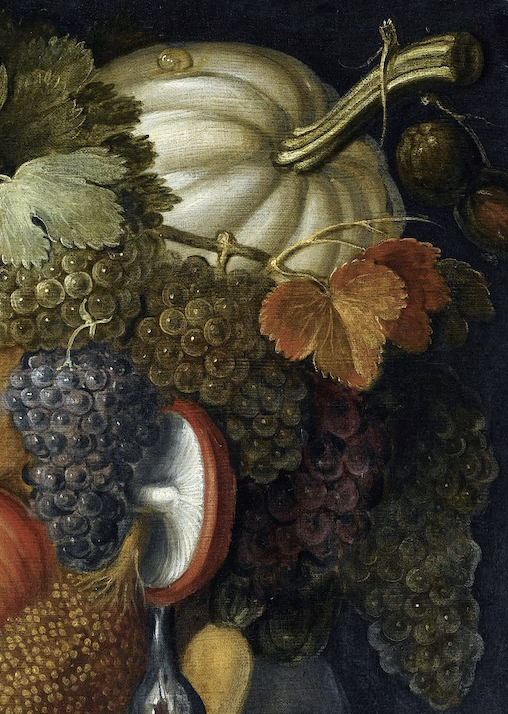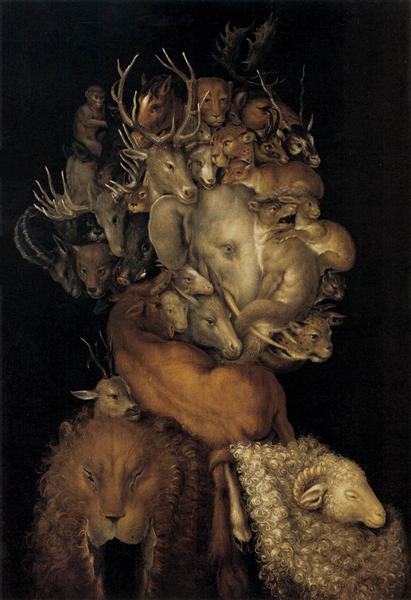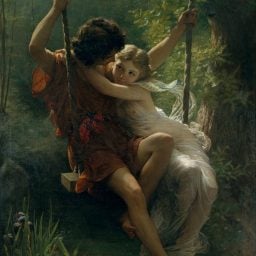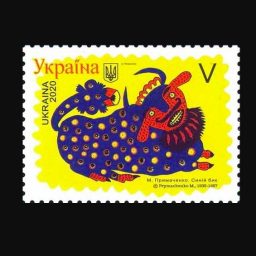With a berry for an eye, a pear for a nose, and grapes and leaves for a crown of hair, Giuseppe Arcimboldo’s faces have maintained a captivating and quizzical presence in art history for nearly 500 years.
Though only 26 of his works survive, Arcimboldo’s composite faces made of fruits, vegetables, flowers, or even books have left an outsize impression on art history. (In actuality, his artistic output was comprised largely of more traditional imagery.)
Born in Milan in 1527, the son of a painter, Arcimboldo began his career painting religious subjects, frescoes, and making stained-glass windows. In 1562, he was appointed court portraitist to Ferdinand I at the Habsburg court. Arcimboldo would paint for the Habsburgs until 1588, first in Vienna for Ferdinand I, and then later for Maximilian II and his son Rudolf II in Prague.
The Habsburgs were known to have a flair for art and culture that extended beyond convention into the worlds of sciences and curiosities, too. At their court, Arcimboldo also acted as the costume designer and made tapestries and stained-glass windows. It is perhaps unsurprising, then, that it was there in the curious court of the Holy Roman Emperor that Acrimbolodo’s vegetal visions flourished.
Arcimboldo’s first allegorical images are perhaps his most famous—the Four Seasons, a series made for Maximillian II in 1563. These “portraits,” Spring, Summer, Autumn, and Winter, were each made up of seasonally appropriate fruits, vegetables, and flora. Spring and Summer appear as youthful women, Autumn and Winter have the visages of grizzled old men.
With the season of harvest upon us, we decided to take a closer look at Arcimboldo’s Autumn and turned up three facts that might just change the way you see it.
1) Autumn Showcased the Habsburg’s Global Reach

Detail of Autumn by Giuseppe Arcimboldo.
The head of a man emerges from a wooden barrel. The neck is made of gourds, the nose is a pear, grapes and grain make the hair, the skull is made of a white pumpkin, the ear a mushroom. Autumn is at once comic and grotesque, but scholars argue that it’s much more than that, too.
“The present-day image of Arcimbaldo as the grandfather of fantastic art and Surrealism is not the historical Arcimboldo. That world of Arcimboldo is not Kafka’s Prague, despite legends about the oddity of his patron Rudolf II,” wrote Thomas Da Costa Kaufmann in the essay “Arcimboldo’s Imperial Allegories.”
Rather than mere whimsies, Arcimboldo’s images often incorporated symbols of science, culture, conquest, and colonialism. The pumpkins and gourds featured in Autumn are vegetables from the New World—these types of gourds were only being introduced into Europe during that century, and their incorporation in this image is meant to be emblematic of the Holy Roman Empire’s wealth, global reach, and cultural centrality.
Arcimboldo’s original version of Autumn, painted in 1563, has sadly been lost, but a complete set of copies of the series made by Arcimboldo in 1573 is in the collection of the Louvre. Though some degree of fidelity may be lost between the original and the copy, the very existence of the copy underscores an essential political function of Arcimboldo’s paintings.
The emperor often had Arcimboldo make additional versions of his allegorical portraits, which the Emperor sent to other significant political figures in a playfully concealed show of his global might. In the case of the Louvre series, the paintings were sent to Augustus of Saxony. Another version of the seasons was made for Philip II of Spain.
2) Autumn Had a Partner Painting

Giuseppe Arcimboldo, Earth (1570).
The “Four Seasons” is often read as a parallel to another of Arcimboldo’s series, “The Elements,” which included paintings of Water, Air, Earth, and Fire, completed in 1566. Both series of works were presented to Maximilian II during an elaborate ceremony in 1569 that likely coincided with the New Year. A poem, “The Picture Seasons and Four Elements of the imperial artist Giuseppe Arcimboldo” by J. Fonteo, accompanied the works and explained a bit of their philosophical significance.
Each season was meant to parallel an element; in this case, Autumn aligns with Earth. What’s more, the two series were made so that each corresponding season and element could be hung facing each other. Ultimately, both series were displayed in Maximilian II’s wunderkammer.
Platonic theory espoused that the universe was composed of four elements in its entirety. Here, the harmony of the seasons and the elements embody the continuing cycles and indeed naturalness of the empire of the Habsburgs themselves—the marriages and subsequent rulers of the empire acting as seasons within a divinely ordained plan.
Political symbolism hints at this too: In the image of Earth, the lion’s skin can be read as alluding to Hercules—itself an allusion to the heraldry of Bohemia. These references, said DaCosta Kaufmann, hint at “the majesty of the ruler, the copiousness of creation, and the power of the ruling family over everything.”
3) Anthromorphozing Fruits and Vegetables Was a Late Renaissance Trend

Niccolò Frangipane, Allegory of Autumn. Collection of Musei Civici Udine.
In his era, Arcimboldo was known as a great study of the sciences, as were the Habsburg emperors for whom he painted. Some have argued that Arcimboldo’s interest in anthropomorphizing fruits, vegetables, and plants in paintings was emblematic of a broader interest in finding often humorous parallels between the human anatomy and the natural world. In the late Renaissance, particularly post-Reformation, interest in the pseudo-science of “the doctrine of signatures”—a belief that plants’ resemblance to various parts of the body signaled that they could be used to medicinally treat those very body parts—peaked.
In his essay “Fruits and Vegetables as Sexual Metaphor in Late Renaissance Rome,” historian John Varrian writes that the “humorous potential of fruit and vegetables may have been further grounded in the popular belief that the shape of certain plants was inherently anthropomorphic. This notion… had been known for centuries by herbalists searching for signs to the efficacy of God’s creations.”











